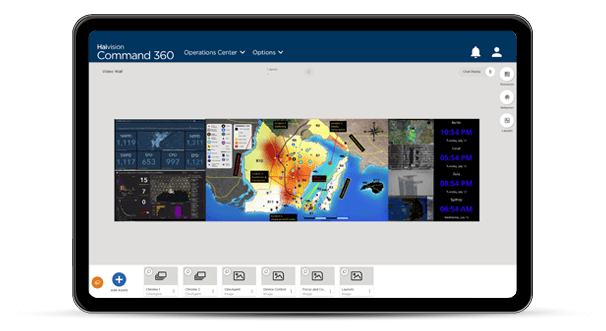The oil and gas industry consists of several sectors, including exploration, production, refining, drilling, and pipeline management. Liquified Natural Gas (LNG), petrochemical companies, and oil service providers also play important roles in national and international markets. These organizations bring staggering quantities of product to consumers at an impressive rate. Companies continue to invest heavily in the modernization of existing equipment and field infrastructure. They are also funding the next generation of data infrastructure. The rise of high-tech, integrated operations centers (IOCs) and new digital solutions dramatically improve safety, security, and situational awareness across the industry.
Dynamic, high performance visual collaboration systems enable a common operating picture (COP) across corporate headquarters, remote sites, offshore platforms, and plant operations. Facilities like IOCs must control, collect, and monitor data to meet multiple objectives: safety compliance, site and data security, production and delivery, quality control, and operational equipment integrity. A host of manual and automated instrumentation and associated software applications support these objectives:
- Motion alert sensors
- Security cameras
- Pressure gauges
- Gas analyzers
- Toxin and flame detectors
- Flow meters
- Temperature monitors
- Switches and transmitters
- Emergency response system
- High-precision gas, fluid, and solid sensors

In addition to routine operations and internal incident response, oil and gas IOCs coordinate with local police, fire, and hazardous material responders. Any malfunction or security breach has the potential to escalate and therefore necessitates notifying local authorities. In worst case scenarios, authorities may implement shelter-in-place or evacuation protocols. The IOCs collaboration platform can help to facilitate real-time situational awareness within the organization and with local public safety teams. Decision makers can better protect lives and property when real-time, streaming video of a developing incident or failure alert content is instantly available.
An effective content control platform allows video wall system operators to prioritize information displayed in an IOC. The interface must meaningfully organize data and interact with applications. It must also simultaneously share data with remote locations, including data centers and other technology-intensive analysis tools in the oil and gas ecosystem. Managing content from these diverse sources should be intuitive. Regardless of technical background, operators need to be free from burdensome system configuration or programming. They must be able to focus their full attention on facility operation and monitoring.
Current business trends for secure, scalable, distributed collaboration touch every industry. Oil and gas is no exception. Industry leaders are embracing a revitalization of technology in a field not often associated with innovative data control and monitoring. Visual collaboration within environments such as IOCs create a solid foundation from which to provide safe, efficient, productive, and environmentally responsible fuel production.
To explore how Haivision’s visual collaboration technology and innovative content management capabilities can enhance your organization’s operations, contact us to schedule a demo!
